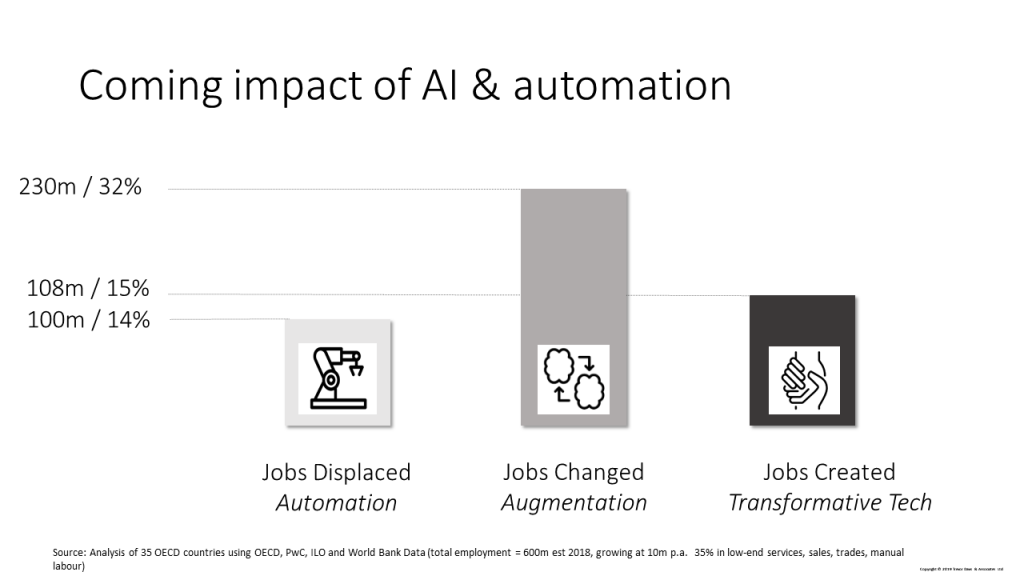I spend a lot of time reading about AI these days. As if I could avoid it: computer vision and machine learning to improve San & Go at Sam’s Club, McDonald’s acquiring startup Dynamic Yield so they can work on personalising customer experience to name two recent articles.
Of course, nothing I read compares to HAL 9000 from the movie 2001: A Space Odyssey. There is no intelligence at work – just lots of data, pattern recognition, image and language processing and some nifty user experience design. Does that mean it is all hype? I don’t think so; I was around AI in the Winter of the 1980s and the slide into the “trough of disappointment” (as Gartner would say) felt inevitable and final. Today I am quite hopeful.
Even without much intelligence recent achievements are impressive. In the last 3 years alone we’ve had AlphaGo beating human Go masters, Domino’s testing self-driving pizza delivery in Michigan and Gallo Winery’s ‘Rosé Your Way’ chatbot snuggling up with consumers on Facebook as they choose their tipple. Machine Learning and Deep Learning algorithms, combined with a step change in availability of data and processing power, have delivered these wonders and I am sure there is more to come. I do wonder where the next breakthrough will come from, but there is no shortage of capital, talent and ideas out there.
For me, however, there is usually something missing when I read these articles. Sure the technology is wondrous and I can see many powerful applications everywhere from consumer and shopper insight, right across the end to end value chain. But where is “Team Human”, as digital theorist Douglass Rushkoff likes to point out.
Which is more compelling: the attraction of AI to augment or replace people? Is AI just a synonym for cost-cutting or are their effectiveness gains too? Naturally the answer is “all of the above”, but if we don’t consider the role of people in the context of these technologies then I believe we are missing an important trick as AI is still learning to walk (practically and metaphorically).
For the foreseeable future keeping people in the loop will bring a level of human contact, agility and intuition that AI doesn’t deliver and our industry sorely needs. So I like the sound of Levi’s AI-informed planograms which help merchandisers refine their instincts about how a store should be laid out. Similarly, I admire the thinking behind Walmart’s Intelligent Retail Lab in Levittown as the technology seems designed to help the people do what people do best.
It is easy to find scary headlines such as Will robots and AI take your job? The economic and political consequences of automation or Will robots take your job? Humans ignore the coming AI revolution at their peril. Read behind and across the literature and you start to see a different picture. Yes, some jobs will go. New jobs will appear. In many cases jobs will stay, but the content of the role will change – hopefully the boring bits will go! Take a look at the chart that I have compiled from a variety of sources to show the coming impact in 35 OECD countries in 2030. The scale on the left shows the change in jobs for jobs displaced or lost to AI, jobs changed through augmentation and what IBM calls “new collar” employment (that’s job creation). My view is that although just about every job will be touched by AI, the risk of mass lay-offs is overstated.
The science fiction writer Arthur C Clarke said “the only way of discovering the limits of the possible is to venture a little way past them into the impossible.” People venture, not technology. That’s where Team Human in Consumer Goods is with AI today – pushing those limits with pilots and proofs of concept.
And, to learn more about how artificial intelligence is impacting the Consumer Goods Forum’s (CGF) members and the consumer goods industry at large, and the exciting opportunities offered, take a look at the content being published as part of the CGF’s E2E Value Chain initiative. Consult our news and resources and search “artificial intelligence” to learn more.
This blog was written and contributed by:
Dr Trevor Davis
FRSA


